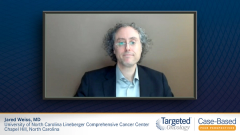
Second-Line Treatment After Maintenance Immunotherapy
Key opinion leader in thoracic oncology, Jared Weiss, MD, discusses the role of second-line treatment for relapsed ES-SCLC after first-line therapy and maintenance immunotherapy.
Episodes in this series
Jared Weiss, MD: All patients relapse, as our case illustrates. Let’s talk about what options are then available in second-line [treatment] for this patient, and in patients like this 1. Of course, we need to come back to patient values. What does the patient want? There’s a spectrum from “Doc, don’t hurt me—let me die in peace” to “Doc, I need to live as long as possible no matter how brutal the adverse effects.” Most patients are somewhere in between. If we want to respect patient values, we need to know them; to know them, we need to start by asking. Our patients have had cancer typically less than a year, so it’s our job to not simply give them cafeteria list options but to educate their values and their decision-making with information.
Let’s talk about that information. Thinking about what’s possible, I start by thinking about whether this is a platinum-sensitive or a platinum-resistant case; there’s something of an intercontinental divide in how this is defined. Historically, in North America, we’ve defined platinum sensitive as at least 6 months of a chemotherapy-treatment-free interval, from the last dose of platinum until progression. In Europe, it’s more commonly defined as 90 days. There’s no clear regression discontinuity between 90 and 180 days; it’s more of a spectrum. With that controversy acknowledged, in a case like this where progression is at 7 months, it’s quite comfortable to call this a platinum-sensitive case.
What can we expect from the reinitiation of platinum if we consider in a case such as this? There was a randomized study for patients with a chemotherapy-treatment-free interval of at least 90 days. That fit this patient, with a randomization between topotecan or carboplatin plus etoposide. Progression-free survival was improved from 2.7 to 4.7 months, but overall survival was not superior to topotecan. So reinitiation of platinum, now or at some subsequent point, would be an option for this patient. Interestingly, other chemotherapeutic second-line options also work better in patients with longer chemotherapy-treatment-free intervals; this may be more of a general marker of cytotoxic sensitivity. Other agents may certainly be considered in this context. Lurbinectedin is approved as a single agent in the second line at a dose of 3.2 mg/m². In noncomparative data, it appears to be a little less toxic and a little more effective than topotecan. Even with this cytotoxic agent, it works better in a patient like this with a longer chemotherapy-treatment-free interval.
With lurbinectedin, overall survival in that basket study was 5 months in those with a chemotherapy-treatment-free interval of less than 90 days. But in a patient like this, with a chemotherapy-treatment-free interval of at least 90 days, it was 12 months. Although lurbinectedin may have appeared less toxic than chemotherapy, it was still toxic consistent with a cytotoxic regimen with myelosuppression being a leading problem. Finally, in considering this patient’s options, is topotecan. Topotecan is not a well-loved drug in thoracic oncology, but it’s been very hard to beat historically. Immunotherapy failed to beat topotecan in the second line, and when the combination of Adriamycin [doxorubicin] and lurbinectedin was compared with dealer’s choice of CAV [cyclophosphamide, doxorubicin, vincristine] or topotecan, there was also a failure to improve survival.
Finally, there’s topotecan. Topotecan is not a well-loved drug in thoracic oncology, but historically it’s been very hard to beat. Immunotherapy failed to beat topotecan in second line. Recently, when Adriamycin and lurbinectedin together were compared with dealer’s choice of CAV [cyclophosphamide, doxorubicin, vincristine] or topotecan in second line, this also failed to beat topotecan. I would note that with preceding trilaciclib, topotecan is less toxic, because its major toxicities are myelosuppression and its downstream sequelae.
Transcript edited for clarity.
Case: A 64-Year-Old Woman with Small-Cell Lung Cancer
Initial Presentation
- A 64-year-old woman presented with a persistent cough, chest discomfort, fatigue and unintended weight loss
- PMH: osteoporosis, hysterectomy at age 60, prediabetic managed with diet and exercise
- SH: 45-pack year smoking history; drinks alcohol 1-2/month socially
- PE: Decreased breath sounds in left lung, wheezing on auscultation, axillary lymph node enlargement
Clinical Workup
- Labs: serum Na 132 mEq/L; ALT 54 IU/L; AST 58 IU/L; all others WNL
- Axillary lymph node biopsy revealed small cell carcinoma
- Chest/abdomen/pelvic CT showed a 7.2 cm mass above the diaphragm, a small contralateral lung nodule and evidence of invasion into the left side of the pericardium
- PET scan showed activity in the left lung above the diaphragm, mediastinum and small hypermetabolic activity in the surrounding area
- Contrast‐enhanced MRI of the head was negative for brain metastases
- Stage IV small-cell lung cancer; ECOG PS 0
Treatment
- Initiated carboplatin + etoposide + atezolizumab for 4 cycles; followed with atezolizumab as maintenance therapy
Follow-up
- 7 months after starting treatment she complained of fatigue, shortness of breath, right upper quadrant pain and back pain
- CT scan showed hematogenous metastases in the liver
- Initiated lurbinectedin 3.2 mg/m2 IV q21 days






































